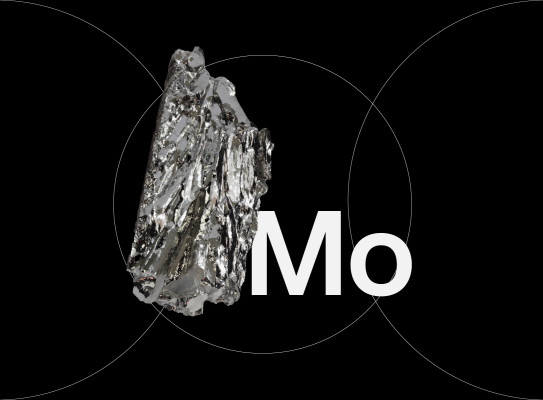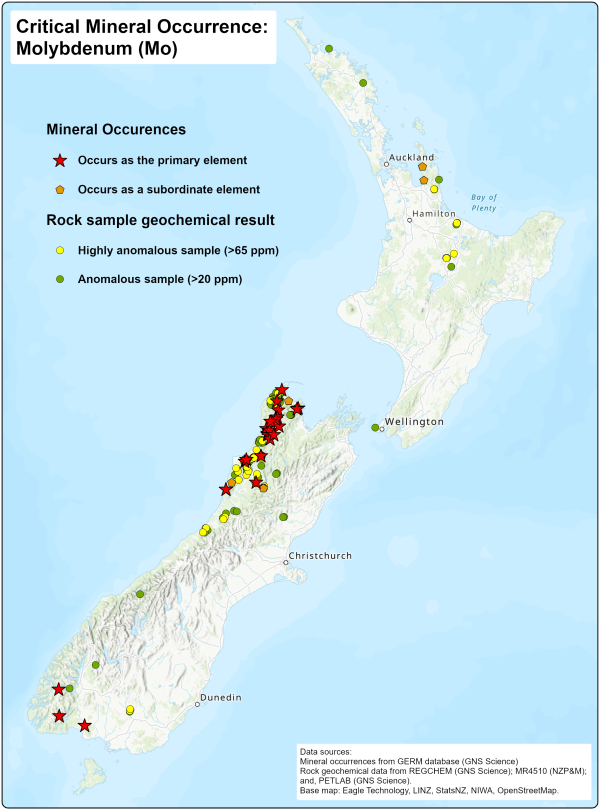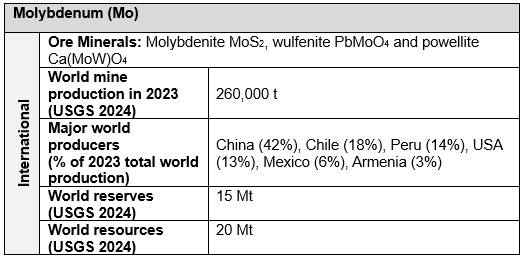Molybdenum

Molybdenum (Mo) is a critical metal known for its high strength, heat resistance, and corrosion resistance. It plays a vital role in steel alloys, industrial catalysts, electronics, and essential biological processes
Molybdenum in New Zealand
Molybdenum is associated with igneous intrusions in the South Island, mostly as Porphyry Mo deposits and epithermal vein deposits in the Hauraki Goldfield – both low-sulfidation and intermediate-sulfidation epithermal deposits.
New Zealand Porphyry Mo Deposits
Exploration in the late 1960s to early 1980s discovered several Porphyry Mo deposits in the northwestern part of the South Island. These are genetically related to the emplacement of Late Cretaceous (120–106 Ma) I-type Separation Point suite granitoids into the Paleozoic S-type granites of the Karamea suite (e.g. Karamea Batholith) or adjacent quartzose metasedimentary rocks of the Aorere and Greenland groups. Most of the deposits are hosted by the metasedimentary rocks or by the intrusive Cretaceous granitic stocks, with a few (e.g. Taipo Spur) hosted in Paleozoic Karamea suite granite.
The geochemistry of the molybdenum-bearing granitoids is characterised by low K₂O, Rb and F, as well as high Sr and Ti, confirming the classification of the deposits as Mo end members of the porphyry Cu-Mo family, also known as quartz-monzonite-type, granodiorite-type and calc-alkaline-type porphyry molybdenum rather than Climax-type.
A slightly older (133.5 Ma) porphyry Mo deposit is associated with the copper skarn mineralisation at Copperstain Creek.

Key Uses of Molybdenum
Steel and Superalloys - Around 80% of molybdenum is used in steel production, improving strength, hardness, and heat resistance in structural steel, stainless steel, and aerospace superalloys.
Catalysts for Industry - Molybdenum-based catalysts are essential in petroleum refining, chemical processing, and emissions reduction.
Electronics & High-Tech - Applications Used in semiconductors, lubricants, coatings, and nuclear energy technologies.
Biological Importance - Molybdenum is a trace element required for enzyme function in plants, animals, and humans, playing a role in nitrogen fixation and metabolism.
Geological Sources of Molybdenum
Molybdenum is primarily found in:
- Porphyry Molybdenum Deposits – Large, low-grade deposits associated with granitic intrusions (e.g., USA, China, Chile).
- Porphyry Copper Deposits – Often a valuable byproduct of copper mining (e.g., Chile, Peru, Canada).
- Skarn and Vein Deposits – Formed by contact metamorphism and hydrothermal fluids, though less common.

Exploration and Mining
The largest producers of molybdenum include China, the USA, Chile, and Peru. Most molybdenum is recovered as a byproduct of copper mining, making it dependent on global copper production trends.
Future Demand and Applications
Molybdenum’s use in clean energy technologies, advanced manufacturing, and aerospace materials is driving increased demand. Its role in nuclear energy, hydrogen production, and next-generation industrial processes positions it as a key metal for future technological advancements.
For geologists and explorers, molybdenum remains an important target due to its economic value, industrial significance, and association with major mineral systems worldwide.
Additional Reading
Eggers AJ, Adams CJ. 1979. Potassium-argon ages of molybdenum mineralisation and associated granites of Bald Hill and correlation with other molybdenum occurrences in the South Island, New Zealand. Economic Geology. 74(3):628–637. https://doi.org/10.2113/gsecongeo.74.3.628(external link)
Tulloch AJ, Rabone SDC. 1993. Mo-bearing granodiorite porphyry plutons of the Early Cretaceous Separation Point Suite, west Nelson, New Zealand. New Zealand Journal of Geology and Geophysics. 36(4):401–408. https://doi.org/10.1080/00288306.1993.9514586(external link)
Christie AB, Brathwaite RL. 1995c. Mineral commodity report 9: molybdenum.
New Zealand Mining. 18: 22-32.
Brathwaite RL, Kamo SL, Faure K. 2004. U-Pb geochronology and geochemistry of molybdenum-bearing granodiorite porphyry at Copperstain Creek, west Nelson, New Zealand. New Zealand Journal of Geology & Geophysics. 47(2):219–225. https://doi.org/10.1080/00288306.2004.9515049(external link)